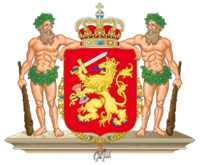Empire of Ahrana: Difference between revisions
No edit summary |
|||
| Line 78: | Line 78: | ||
==The Period of Peace== | ==The Period of Peace== | ||
==The Period of Decline== | ==The Period of Decline== | ||
=Administration= | |||
The Empire of Ahrana was administered through an Absolute Monarchy with the Emperor being the main source of power in the Imperial Government at the time. | |||
{{Ahrana Navbox}} {{Eurth}} | {{Ahrana Navbox}} {{Eurth}} | ||
[[Category: Ahrana]] | [[Category: Ahrana]] | ||
Revision as of 00:39, 29 November 2022
This article is incomplete because it is pending further input from participants, or it is a work-in-progress by one author. Please comment on this article's talk page to share your input, comments and questions. Note: To contribute to this article, you may need to seek help from the author(s) of this page. |
Ahranaian Empire
| |
|---|---|
| 500 BCE to 1539 CE | |
| Capital | Vulga Supra, Peterburi, Moskova |
| Common languages | |
| Religion | Orthodox |
| Government | Mixed, functionally absolute monarchy |
| Historical era | Classical to Middle Ages |
| Today part of | |
The Empire of Ahrana or the Ahranaian Empire was the ancient state located in Central Argic region of Argis on Eurth. The lands that made up the empire proper was and still is considered the homeland of the ancient Ahranaians. Through the brutal domination and ethnic polcies the empire practiced at the time; the empire was seen as the leading state of Central Argis at the time till around 1495 CE. The Empire of Ahrana was proclaimed around 500 BC and ended in 1535 CE.
History
It is believed through the written documents left behind by the early days of the Ahranaian Empire that the start of an Empire was around 500 BCE with the House of Olaf and ended officially in 1535 CE when the last Emperor declared the Empire as, "Days of old, now long gone for the last several decades." The Empire would be succeeded by the Imperial Kingdom of Ahrana in the core lands of the Empire.
Through sheer brute force, the Ahranaians conquered vast number of lands to the North, East, South, and West of the early ancient city states. The Empire would encompass many peoples, languages, and religions throughout the Central Part of Argis.
Pre-Empire
The ancient states of Ofan stað, Selvagr, Skevio, and Hestr made up the early lands of what would become Xara or the Empire of Stríð. During the last remaining years of the three remaining City States were dominating by three powerful houses that paid tribute to the King of Stríð. The House of Olaf, House of Eskildsen, and the House of Sigmond made up the three ruling houses of the city states. The Royal House of Dahl ruled the entire land of Stríð which is also known as Xara. During the rule of Erik of the House of Dahl, the House of Olaf was elevated from Earl status to the status of a Duke therefore elevating the lands of the House of Olaf to the second highest rank of all the lands under the Royal House. Under the first Duke of the House of Olaf, Duke Olaf the Inconceivable, the lands of Selvagr would grow which would be enough to even rival the Royal House lands.
The House of Dahl would end with abrupt end in the Royal Bloodline with the rule of Borje the Weak. Due to several marriages during the mid-City States Era the House of Olaf was the closest by male birth to inherent the Royal Throne of Stríð. Thus, during the lifetime of Olaf the Inconceivable in 566 BCE the throne became intertwined with the House of Olaf and its descendants.
During the remaining rule of Olaf the Inconceivable as both Duke and King, the centralization of power under the new ruling house would start to come into effect. At the beginning of the integration of Royal Power into the Ducal Power of the House of Olaf was resisted by the other two remaining City States of Stríð, however as time progressed under two other successors to Olaf the Inconceivable the centralization of power was achieved.
When Olaf the Wise came to power in 550 BCE through succession to his father to the Throne to both the Ducal lands and Royal Lands, he decided to continue the centralization process by forcing the rest of the nobles to submit to the Royal Hand of the House of Olaf as the ultimate ruler of all Stríð. Through many bloody battles and a period of war for two years across the known lands, an early peace was achieved that would remain for at least twenty (20) years before the next set of wars broke out.
During the two years known as the era of Blóðstríð or the Wars of Blood, was some of the early empires bloodiest battles known at the time. During these two years the House of Eskildsen, and the House of Sigmond joined forces together to try and defeat the House of Olaf for the title of Kingship of all Stríð. We know that this war did not go to plan as the House of Olaf still came out on top of both houses. It was during this Era of Warfare that the end of the City States would come forth and the Houses of Eskildsen and Sigmond would come to a quick end. Olaf the Wise would wipe out all bloodlines to these two houses to avoid any more wars over the Royal Throne and City State Status.
After the twenty years of relative peace between all peoples of the early Empire of Stríð, the period of peace would come to an end when a lesser noble house dared to challenge the House of Olaf for the throne. The House of Hansen, who controlled the former lands of the House of Sigmond, would raise an army to march on Vulga Supra and attempt to sack the city and kill all Royal Members of the House of Olaf. This attempt on the capital was thwarted but in response the rest of the nobility started to chose sides and start the era known as Tímabil átta styrjalda or the Era of eight wars. During this period eight brutal wars would start during this twenty-eight (28) year period, which lasted the rest of the reign of Olaf the Wise who never saw peace again.
During the reign of Stefan the Strongwilled, which was between 500 BCE to 480 BCE, the era of the eight wars came to an end with a marriage between the House of Hansen and the Royal House. Stefan would allow his younger sister to marry the Earl of the lands of Hansen. Stefan would be the king that would seek to establish the foundation for a strong empire to exist. During his reign taxes were created and collected in a manner never done before, soldiers ensured peace in troubled lands.
The ensuing years after the long era of wars, the reign of Stefan would be marked by the consolidation of the Royal Authority with the creation of an Imperial Seal which would be the leading factor to create the Empire. The last remaining years of the reign of Stefan he worked on allowing his brother to have more authority in the Royal Government. Upon his death Olaf was made his successor and declared Emperor of the Empire.
Empire Declared
The Period of Growth
The Period of Peace
The Period of Decline
Administration
The Empire of Ahrana was administered through an Absolute Monarchy with the Emperor being the main source of power in the Imperial Government at the time.


